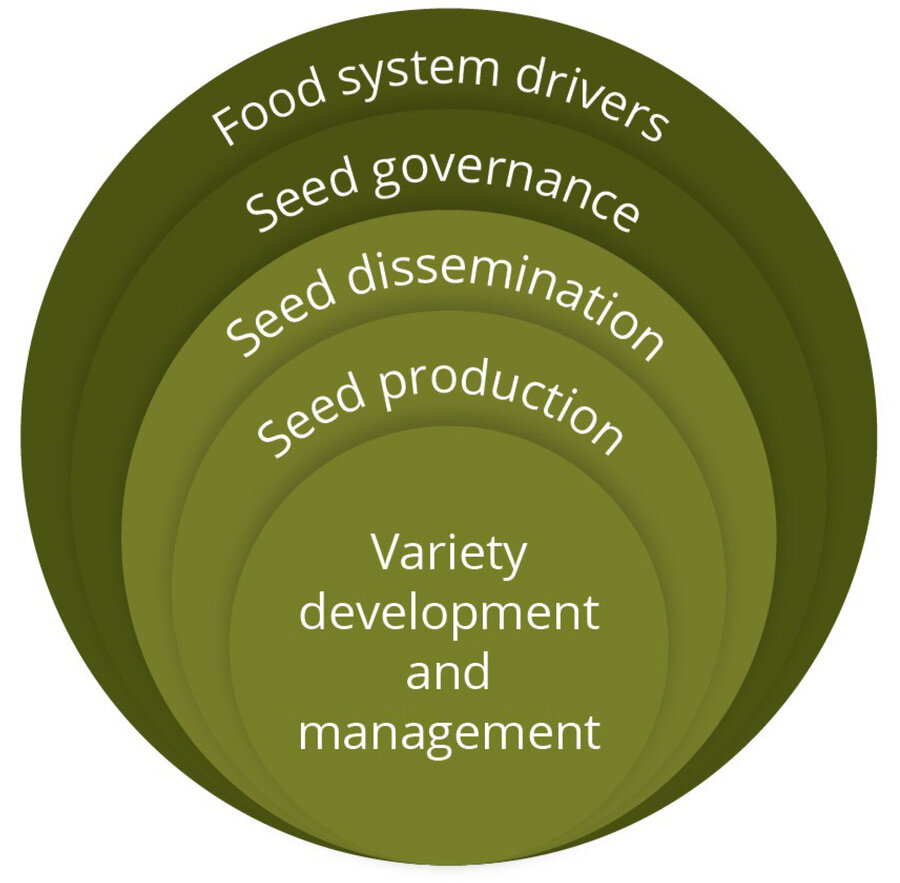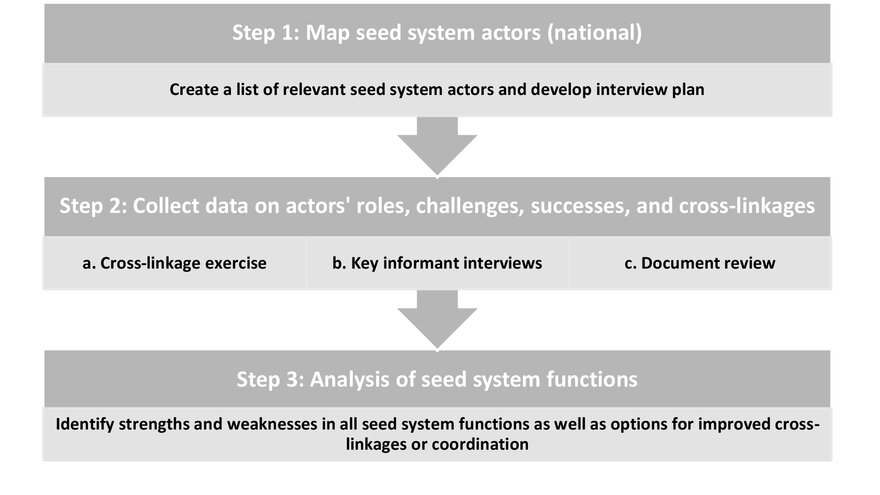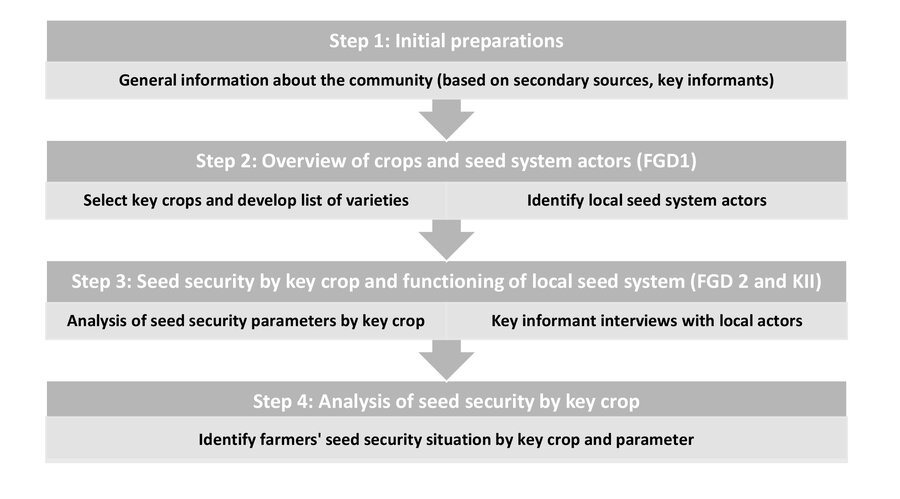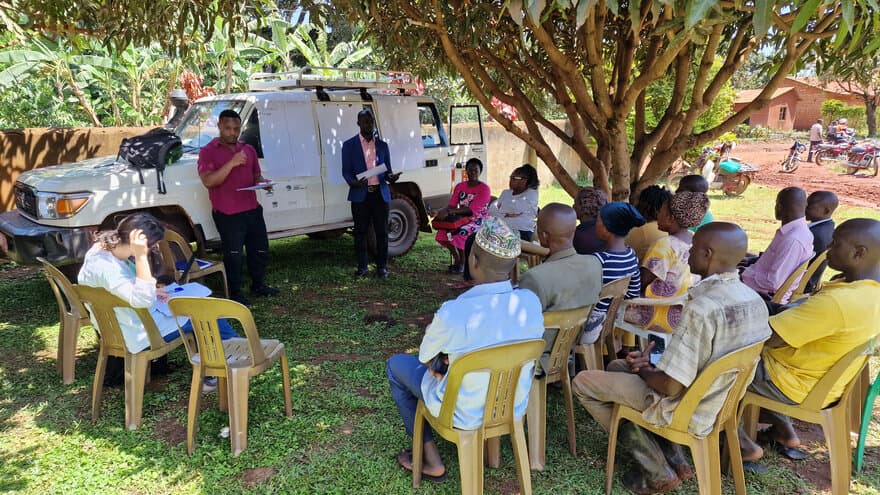What is the Seed System Toolkit?
This section presents the toolkit that is being used for the research phase (2021-2024) of the Genebanks and Seed Systems component of the Biodiversity for Opportunities, Livelihoods and Development (BOLD) project.
The development of the toolkit was coordinated by the Seed System Lab at the Norwegian University of Life Sciences (NMBU) in collaboration with the Alliance of Bioversity and CIAT (Uganda), Plant Genetic Resources Centre (Uganda), National Plant Genetic Resources Centre (Tanzania), the Comité Central de Mujeres de la UNORCAC (Ecuador), the Instituto Nacional de Investigaciones Agropecuarias (Ecuador), and the National Biodiversity Centre (Bhutan).
The toolkit draws on elements from several existing research tools and methods published by several other institutions, as described in section D.
The toolkit is intended for use by the BOLD research teams. The tools may also be used or adapted by other researchers/projects interested in characterizing and analysing seed systems.Download the introduction to the toolkit or browse the content below. Versions in Spanish and Swahili are available upon request.
Contact
A. Background
The goal of BOLD’s Genebanks and Seed Systems component is to investigate both existing and potential ways to link genebanks to seed systems used by farmers and to support innovative pilot efforts to test these. For this purpose, NMBU, in collaboration with research partners, will conduct seed system research in four countries during the first phase (2022-2024) of the project. The primary purpose of the research is to identify options (technical and institutional) for supporting genebanks to proactively work with downstream seed system development initiatives as a sustainable pathway to enhance farmers’ access to and uptake of crop diversity.
The research will consist of the following three components:- i. National seed system characterization
Seed systems at the national level will be characterized by mapping and assessing seed system actors’ roles/mandates, activities, and performances, as well as the institutional (formal and informal) and other factors influencing farmers’ access to seeds of a diversity of crop varieties. The overall aim is to identify strengths and weaknesses in the functioning of the seed system and analyse how these are influenced by governance, institutional, technical and other factors. We also aim to understand seed system actors’ views on seed system development and how these differ among actors. - ii. Local seed system characterization
Seed systems at the local level will be characterized by mapping the seed sources farmers use, identifying seed security challenges farmers face and exploring how these are affected by cultural, political, climate, market, or other factors. The local seed system characterization will serve to identify farmers’ preferences and needs and provide insights into how the seed system is functioning to meet these preferences and needs at the local level. - iii. Analysis of potential genebank-seed system linkages
Based on the above analyses, practical ways of linking genebanks with selected seed system actors will be identified during the research process and used to develop a draft “Theories of Change”. This will be further developed and validated with seed system actors in a roundtable workshop.
- i. National seed system characterization
B. Conceptual framework
We propose using two related concepts to frame the research: seed systems and seed security. These concepts are outlined briefly below; for a more in depth discussion, refer to Westengen et al. (2023).
Seed systems are understood as the institutional arrangements, roles, and activities of actors involved in the maintenance of crop diversity, breeding and selection, seed production, and dissemination (Almekinders et al., 1994; Louwaars & de Boef, 2012). In short, they are the systems that make seeds available to farmers.
In theory, a well-functioning seed system will ensure seed security for all farmers, i.e., that “men and women within the household have sufficient access to adequate quantities of good quality seed and planting materials of preferred crop varieties at all times in both good and bad cropping seasons” (FAO, 2016).
In reality, this is rarely the case and seed systems can be disrupted both by acute stresses such as conflicts and disasters, and chronic problems relating to social inequalities, inefficiencies or lack of coordination between actors, or inappropriate policies etc. (Bentley et al., 2018; Madin et al., 2022; McGuire & Sperling, 2016; Mulesa et al., 2021).
Thus, it is important to recognize that seed systems – and by extension – farmers’ seed security, are influenced by the broader context in which they operate. In this regard, seed systems can be understood to be embedded within the broader food system, and their functioning influenced by a number of drivers (i.e., sociocultural, economic, political, institutional, biophysical, technological, infrastructure, etc.) (HLPE, 2020; Mausch et al., 2021). From the perspective of food sovereignty (i.e., seed sovereignty), questions are also raised about who has political and economic control over seeds (Bezner Kerr, 2013; Hernández et al., 2020).
Although it has generally been common to distinguish between different types of seed systems such as informal or formal seed systems, there are many linkages and interdependencies between these and farmers often source seed originating from both (Almekinders & Louwaars, 2002). Furthermore, the terms themselves are imprecise and can reinforce misconceptions. For instance, the term “informal” can misleadingly imply that such seed systems are not rule-governed, while “local” suggests that seed only circulates at limited geographic scales, while there is ample evidence to the contrary (Coomes et al., 2015). Recent literature (Christinck et al., 2018) suggests that seed system characterization based on their functions can help design more need-based seed system development programs.
Based on this understanding, we therefore identify five factors to characterize seed systems. These include three “functions” representing the core activities performed by actors in the seed system, and two “contextual factors” that enhance or constrain the functioning of seed systems due to their influence on actors’ roles and activities (Figure 1).
Figure 1. Conceptual framework identifying five factors to describe seed systems. The three in light green are basic "functions" that seed systems deliver. These are activities that seed system actors are engaged with. The two in dark green (seed governance and food system drivers) are broader contextual factors that influence how the seed system functions. Photo: NMBU Our characterization of seed systems at local and national levels, refers to the scale of the analysis rather than the type of seed system. In the national seed system characterization, we examine the functioning of the seed system operating at the national scale, be they “formal” or “informal”. In some countries, policies, regulatory frameworks and institutions may have greater focus on supporting functions within the formal seed system. However, by structuring our analysis using the five factors described above, we will aim to integrate analysis of all types of seed systems. Similarly, the local seed system characterization is aimed to zoom in to assess how seed systems are functioning in specific localities, e.g., the strengths and weaknesses of seed production by different producers both in the formal and informal seed systems. Examples of how each of the five factors can be applied at national and local levels are described in Table 1.
Types of activities included at national and local levels Variety development and management Variety development and management is about the plant genetic resource base (cultivated and wild relatives) used by farmers and breeders. In seed system characterization at the national level, this component deals with the actors involved in germplasm conservation and management and plant breeding activities, including their strategies and performances. At the local level, it focuses on crops and varieties farmers grow and manage on-farm. Seed production Seed production involves producing diverse quality seeds of different crops and varieties. Seed producers include both farming households and specialized groups/enterprises, to increase seed availability and choice for farmers. In seed system characterization at the national level, this component deals with mapping actors involved in seed production of different seed classes (e.g., early generation seed and seeds farmers use for grain/crop production) and seed quality (e.g., certified, quality declared, and uncertified). It also deals with their priorities, strategies, and performances to ensure seed availability. At the local level, it deals with seeds produced by farming households and specialized groups, their focus crops, and source seed as input for multiplication, storage, and quality issues, including identifying existing constraints and opportunities. Seed dissemination Seed dissemination is about making seeds from all sources available for use by farmers. National-level characterization looks at key actors working to distribute available seeds and make them accessible to farmers. It investigates actors’ performances, strengths, and weaknesses in seed dissemination and their strategies related to price, credit, information dissemination, and seed delivery channels. At the local level, this is about seed sources used by farmers and the main seed transaction types used to acquire seed from each source, including exchange, gift, sale, etc. Seed governance Seed governance includes the formal and informal rules and institutions that relate to the seed system functions and the interactions within and between the actors involved. At the national level, this component involves identifying national policies and regulatory frameworks developed by the government to domesticate international agreements related to seed system functions. It also examines whether there is harmonization or conflict between the different policies and regulations, including social norms and informal practices that affect seed system functions. Institutional arrangements and rules governing actors’ interaction are important aspects of seed governance. At the local level, seed governance deals with rules or regulations of government agencies or other institutions, as well as customs, beliefs or norms at community level that affect farmers’ practices in variety development and management, seed production, saving, marketing, exchanging, or use. Food system drivers Seed systems are also shaped by the broader food systems they are part of. Agricultural policy agendas from donors and governments, trade agreements and agribusiness interests, technological capacity are all important drivers of seed system development. Furthermore, environmental changes such as biodiversity loss and climate change also fundamentally shape the seed system landscape. At the national level, this component of seed characterization looks at how these food system drivers affect seed system actors’ priorities and choices. At the local level, it examines how these drivers affects farmers’ access to preferred crops, varieties, and types of seeds. Table 1. Seed system functions/contexts and how they can be applied at national and local level. To understand the extent to which seed systems meet farmers’ preferences and needs, we propose using the seed security framework (FAO, 2016). Seed security assessment focuses on understanding how well the seed system enables farmers to obtain seeds, focusing on four main parameters (Table 2).
Parameter Definition Varietal Suitability Extent to which available crop varieties are preferred and adapted to farmer conditions Seed Availability Quantity of seed available (from all sources) is sufficient to meet farmers’ needs Seed Access Farmers have the means to obtain seeds through cash, loan, barter, or gift. It can also include having access to information about the seed and where to obtain it. Seed Quality Quality attributes such as germination, physical purity, moisture content, seed health, and – for some crops – genetic/varietal and physical purity are acceptable to farmers. Table 2. Seed security parameters and definitions. Based on FAO (2016) Seed security experienced by farmers can be understood as an outcome of the seed system (Puskur et al., 2021). In this regard, a well-functioning seed system should contribute to seed security for farmers. On the other hand, seed insecurity can reflect shortcomings in the functioning of the seed system (Bentley et al., 2018), including dynamics related to any of the factors shown in Figure 1.
In summary, we will use the five seed system factors shown in Figure 1 to structure the characterization of seed systems at both national and local levels. In addition, the seed security framework will be used to explore how well seed systems meet farmers’ needs and preferences at local level.C. Methods and tools
In this section we provide an overview of the approach for the national and local seed system characterizations, and outline the data collection methods and the tools included in the Genebank and Seed Systems Toolkit.
i. National seed system characterization
The main steps in the national seed system characterization are outlined in the figure below. Methods include key informant interviews, workshop discussions and document review.

The main steps in the national seed system characterization. Photo: NMBU Step 1. Map and seed system actors
The first step consists of mapping the relevant stakeholders that are engaged in the seed system within the country. This includes identifying both the organzations, programs or businesses, as well as knowledgeable people within these organizations.
- This mapping should be done by consulting with individuals with good networks/knowledge of the country’s seed systems as well as publications, documents or websites.
- Identification of actors at local level is included in the local seed system characterization.
Tool: Format for Key Informant interview plan
Tip: It is recommended that identified key informants from all actors be contacted ahead of time to schedule the interview.
Step 2: Collect data on actors’ roles, challenges, successes, and cross-linkages
a. Cross-linkage exercise: This exercise will be conducted during the launch workshop with participation of different seed system actors identified in step 1. It will provide an initial overview of the roles, activities and cross-linkages among seed system actors. The results will be summarized in a workshop report.
Tool: Cross-linkages among seed system actors
b. Key informant interviews (KII): Interviews will be conducted with different seed system actors to discuss in more depth their activities within the seed system (including strengths, weaknesses, and how they are influenced by governance and other factors) as well as their views on seed system development.
Tool: Checklists for KIIs (by actor)
Guidance:
- There is a separate checklist/guide questions for each category of seed system actor. Checklists #1-#4 are for local actors; checklists #5-#11 are for national actors.
- Guidance is provided at the beginning of each checklist on the target group (description of actor) and who should be interviewed.
- Prior informed consent must be obtained from all informants before starting the interview (oral or written consent based on the practices in each country).
- The interviewer should use the checklist to ensure that all topics are covered. The interview itself will often not follow the same order/structure as the checklist. This is fine as long as all topics are covered.
- All interviews should be recorded and fully transcribed. Additionally, notes should be taken in case there are problems with the recording.
- Obtain copies (preferably digital) of any documents that the key informant provides about their organization and activities
c. Document review: document review will be used to collect quantitative information on national seed demand and distribution for key crops and to analyse relevant policies, laws and regulations.
Tool: Seed demand and distribution profiles
Tool: Checklist of policy documents to compile
Tip: key informants can be a good source of relevant documentation. When preparing for each KII prepare a list of documents or information you might be able to request from the informant.
Step 3. Analysis of seed system functions
Data from KII transcripts, relevant sections of FGD reports, policy documents, seed demand and distribution profiles, and launch workshop reports will be analysed to identify strengths and weaknesses in all seed system functions as well as options for improved cross-linkages or coordination.
ii. Local seed system characterization
The main steps in the local seed system characterization are outlined in the figure below. The main methods include focus group discussions (FGDs) with farmers and key informant interviews (KII) with local seed system actors.

The main steps in the local seed system characterization. Photo: NMBU Step 1: Initial preparations
The local seed system characterization will be carried out in select communities. Communities will be selected purposively to represent different types of seed systems, agroecologies and crops in the country. The sampling plan will depend on the country context and resources available, but generally will include 4-10 communities.
For each community, the following preparations should be carried out before starting FGDs:- Initial contact with community/local administrative leaders to explain about the project and obtain consent/permission to conduct the study, agree on how to organize FGDs with farmers
- Compile general information on community from secondary sources, local administration, agriculture offices, and key informants
Tool: FGD_General information on the community
Step 2: Overview of crops and seed system actors (FGD1)
The aim of the FGD1 is to gain an overview of some key aspects of the cropping and seed system. It will serve to identify key crops for the seed security analysis in step 3 as well as identify local seed system actors for KIIs.
Tool: FGD1_Overview crops and seed system actors
Guidance: see general guidance for both FGDs below.
Step 3: Seed security by key crop and functioning of local seed system (FGD2 and KII)
Seed security is at the heart of the local seed system characterization. The aim of FGD2 is to assess farmers’ seed security situation by identifying seed sources and examining each of the four seed security parameters (see Table 2). The analysis is done separately for each key crop.
FGD2 should be conducted only after FGD1 is completed, key crops have been selected and a preliminary list of varieties currently and/or previously in the community has been developed for each key crop.
Up to three key crops per community should be selected. Examples of criteria include high importance (for food, income, climate adaptation, etc.) to men and women in the community, challenges in crop/seed production or storage, and strategic interest for genebank linkages.
If the varietal diversity of any of the key crops is very high, the 4-cell analysis (exercise to assess varietal diversity and suitability) can take a long time. In this case, it may be necessary to plan more than one session to complete FGD2.Tool: FGD2_Seed security by key crop
General guidance for FGDs (both FGD1 and FGD2):
- A pre-test of the FGD should be conducted before starting data collection and adjustments made as necessary.
- Focus groups should generally be gender-disaggregated (separate FGD for women and men).
- For the FGDs to yield fruitful information on the functioning of local seed systems, it is recommended that interviewers/facilitators be familiar with and sensitive to local contexts and cultural practices. For example, it is recommended that the interviewers/facilitators speak the local languages, women farmers are interviewed by female interviewers/facilitators, and male farmers are interviewed by male interviewers/facilitators.
- Focus groups should be composed of approximately 6-8 people each. Participants should all be actively engaged in farming. Consider other sources of variation (ethnic identity, age, socio-economic status) to ensure representation of different views.
- Prior informed consent must be obtained from participants before starting the FGD.
- The FGD should be documented in several different ways to ensure that information shared by participants is not lost: 1) audio recording, 2) photos of all flip charts or other visuals used, 3) notes of discussions.
- Conducting FGDs generally requires a team of two to three people: a facilitator to guide the discussions with the group, a note-taker (also responsible for the audio-recording) and another support person for logistics.
- Care should be taken to ensure that all group members have the opportunity to participate in the discussion. Any difficulties encountered while conducting the FGD should be noted.
- The results from the FGD will be compiled in an FGD report (format to be provided). Audio-recordings and notes will be carefully reviewed to ensure that participants’ discussions and are accurately included.
- Any difficulties encountered while conducting the FGD should also be documented and noted in the FGD report.
Key informant interviews (local actors): KIIs with relevant local seed system actors will be carried out in the selected communities/study sites. This will be done concurrently with the data collection for the FGDs. The results from the KIIs at local level will be summarized across study sites and analysed as part of the national seed system characterization. See guidance on tools and other procedures above, in the section on national seed system characterization.
Step 4: Analysis of seed security by key crop
Results from the FGD reports will be analysed to identify seed security challenges in the target communities and how these relate to functioning of the seed system in terms of farmers’ preferences and needs.
D. Sources consulted
The Genebank and Seed System Toolkit draws on elements from the following sources.
Local seed system sharacterization:
• Many elements of the FGD Guidelines and some of the KII Checklists are adapted from: 'Community-Based Assessment' and 'Key Informant Guides' published by Seedsystem.org.
• 'Four cell analysis' method included in FGD2 is based on manuals published by Bioversity On-farm management of agricultural biodiversity in Nepal and CGIAR’s User guide to the four-square method for intervening in root, tuber and banana seed systems.National seed system characterization:
• The approach for the national seed system characterization draws on elements from ISSD’s Seed systems analysis, ZEF (Center for Development Research) Working Papers, and the CGIAR’s multistakeholder framework.
• The 'National seed demend and distribution profiles' tool is adapted from the African Seed Access Index (TASAI).
• The 'Cross-linkage among seed system actors' exercise is adapted from the 'System Dynamics' tool, published in Chevalier & Buckles’ (2013) Handbook for Participatory Action Research: SAS2 Dialogue.Parts of the text in this conceptual framework document is drawn from the publication Navigating toward resilient and inclusive seed systems (Westengen et al. 2023). This Open Access article is distributed under Creative Commons Attribution License 4.0 (CC BY).
E. References and acknowledgements
References:
Almekinders, C. J. M., & Louwaars, N. P. (2002). The Importance of the Farmers' Seed Systems in a Functional National Seed Sector. Journal of New Seeds, 4(1-2), 15-33.
Almekinders, C. J. M., Louwaars, N. P., & De Bruijn, G. H. (1994). Local seed systems and their importance for an improved seed supply in developing countries. Euphytica, 78(3), 207-216.
Bentley, J. W., Andrade-Piedra, J., Demo, P., Dzomeku, B., Jacobsen, K., Kikulwe, E., Kromann, P., Kumar, P. L., McEwan, M., Mudege, N., Ogero, K., Okechukwu, R., Orrego, R., Ospina, B., Sperling, L., Walsh, S., & Thiele, G. (2018). Understanding root, tuber, and banana seed systems and coordination breakdown: a multi-stakeholder framework. Journal of Crop Improvement, 32(5), 599-621.
Bezner Kerr, R. (2013). Seed struggles and food sovereignty in northern Malawi. The Journal of Peasant Studies, 40(5), 867-897.
Christinck, A., Rattunde, F., Mulinge, W., & Weltzien, E. (2018). Identifying options for the development of sustainable seed systems: Insights from Kenya and Mali (ZEF Working Paper Series No. 165, Issue. C. f. D. R. (ZEF).
Coomes, O. T., McGuire, S. J., Garine, E., Caillon, S., McKey, D., Demeulenaere, E., Jarvis, D., Aistara, G., Barnaud, A., & Clouvel, P. (2015). Farmer seed networks make a limited contribution to agriculture? Four common misconceptions. Food Policy, 56, 41-50.
FAO. (2016). Seed security assessment: a practitioner's guide. Food and Agriculture Organization of the United Nations (FAO).
Hernández, C., Perales, H., & Jaffee, D. (2020). “Without Food there is No Resistance”: The impact of the Zapatista conflict on agrobiodiversity and seed sovereignty in Chiapas, Mexico. Geoforum.
HLPE. (2020). Food security and nutrition: building a global narrative towards 2030. A report by the High Level Panel of Experts on Food Security and Nutrition of the Committee on World Food Security. High Level Panel of Experts on Food Security and Nutrition (HLPE).
Louwaars, N. P., & de Boef, W. S. (2012). Integrated seed sector development in Africa: a conceptual framework for creating coherence between practices, programs, and policies. Journal of Crop Improvement, 26(1), 39-59.
Madin, M. B., Nyantakyi-Frimpong, H., & Inkoom, D. K. B. (2022). Seed security among smallholder farmers in semi-arid Ghana. Environmental Challenges, 100438.Mausch, K., Almekinders, C. J. M., Hambloch, C., & McEwan, M. A. (2021). Putting diverse farming households’ preferences and needs at the centre of seed system development. Outlook on Agriculture.
McGuire, S., & Sperling, L. (2016). Seed systems smallholder farmers use. Food Security, 8(1), 179-195.
Mulesa, T. H., Dalle, S. P., Makate, C., Haug, R., & Westengen, O. T. (2021). Pluralistic Seed System Development: A Path to Seed Security? Agronomy, 11(2), 372.
Puskur, R., Mudege, N., Njuguna-Mungai, E., Nchanji, E., Vernooy, R., Galiè, A., & Najjar, D. (2021). Moving beyond reaching women in seed systems development. In R. Pyburn & A. van Eerdewijk (Eds.), Advancing gender equality through agricultural and environmental research: Past, present, and future (pp. 113-145). International Food Policy Research Institute.
Westengen, O. T., Dalle, S. P., & Mulesa, T. H. (2023). Navigating toward resilient and inclusive seed systems. Proceedings of the National Academy of Sciences, 120(14), e2218777120.Acknowledgement:
This research was supported by the Biodiversity for Opportunities, Livelihoods and Development (BOLD) project, led by the Crop Trust and financed by the Norwegian Agency for Development Cooperation (Norad).
Cross-linkages among seed system actors
Key informant interviews



